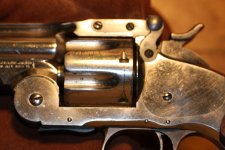This Schofield is from my late father's collection. A couple of questions for the forum
1) The gun is marked "US". However is the nickel plating original to the gov contract or post gov service? The plating looks period to the gun's early years and looks to be a professional job.
2) Are S&W's of this type and vintage generally holding value? Or is collector interest (and hence premium values) moving to smokeless SW's?
I would appreciate thoughts on value for this particular Schofield.
1) The gun is marked "US". However is the nickel plating original to the gov contract or post gov service? The plating looks period to the gun's early years and looks to be a professional job.
2) Are S&W's of this type and vintage generally holding value? Or is collector interest (and hence premium values) moving to smokeless SW's?
I would appreciate thoughts on value for this particular Schofield.




